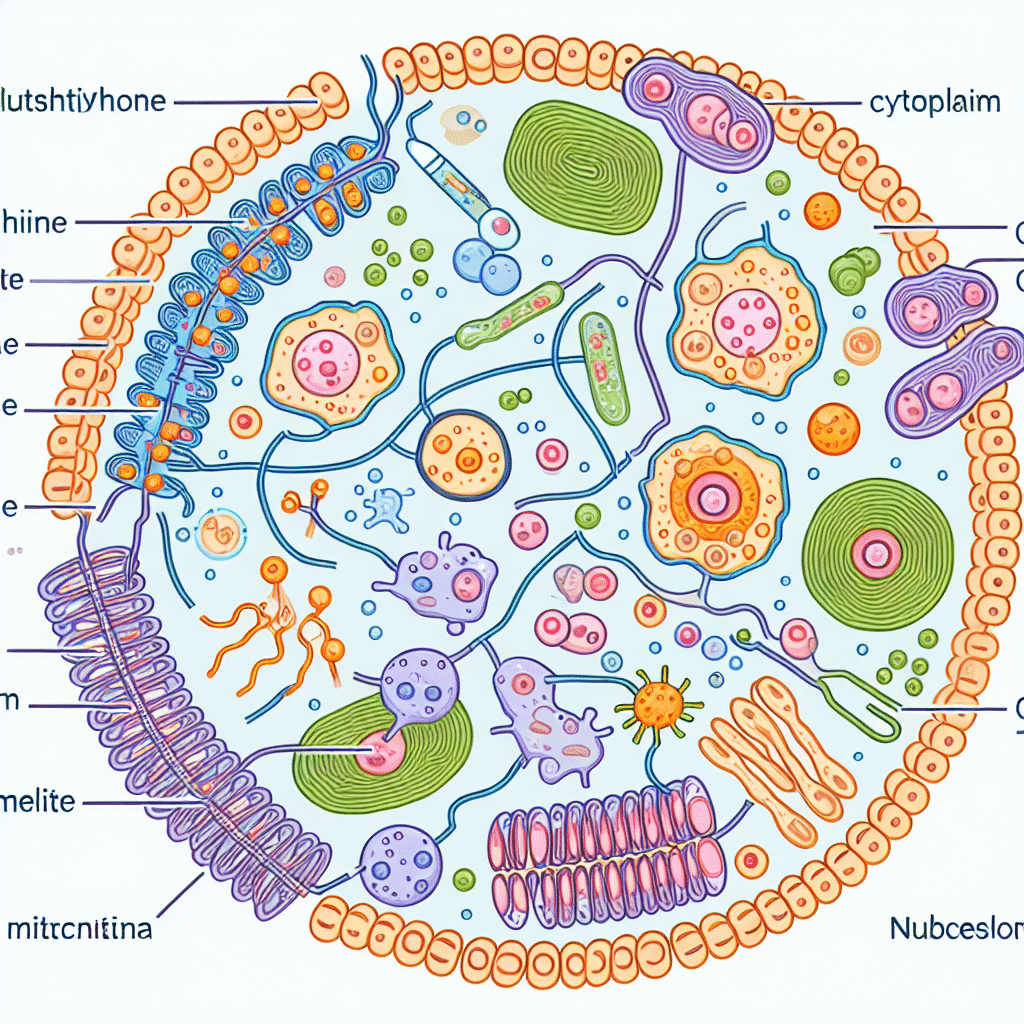Glutathione Cysteine and Homocysteine Distribution in Cells
-
Table of Contents
- Exploring Glutathione, Cysteine, and Homocysteine Distribution in Cells
- The Importance of Sulfur-Containing Amino Acids
- Glutathione: The Master Antioxidant
- Cysteine: A Key Component
- Homocysteine: A Double-Edged Sword
- Distribution and Regulation of Glutathione, Cysteine, and Homocysteine
- Glutathione, Cysteine, and Homocysteine in Health and Disease
- Conclusion: The Delicate Balance Within Cells
- Enhance Your Health with ETprotein’s High-Quality Protein Products
Exploring Glutathione, Cysteine, and Homocysteine Distribution in Cells

Understanding the distribution and function of glutathione, cysteine, and homocysteine within cells is crucial for comprehending cellular health and the mechanisms of various diseases. These molecules play significant roles in maintaining the redox balance, facilitating detoxification, and serving as precursors for protein synthesis. This article delves into the intricate world of these sulfur-containing amino acids and their derivatives, shedding light on their cellular distribution and importance.
The Importance of Sulfur-Containing Amino Acids
Sulfur-containing amino acids such as cysteine and methionine are vital for numerous biological processes. They are involved in the synthesis of proteins, peptides, and other important molecules like glutathione, coenzyme A, and taurine. The metabolism of these amino acids leads to the production of homocysteine, a critical intermediate that can be both beneficial and harmful, depending on its concentration and the body’s ability to regulate it.
Glutathione: The Master Antioxidant
Glutathione (GSH) is often referred to as the master antioxidant due to its central role in protecting cells from oxidative stress. It is a tripeptide composed of glutamate, cysteine, and glycine, and its thiol (sulfhydryl) group is responsible for its antioxidant properties. GSH is synthesized within cells in two ATP-dependent steps:
- The first step is catalyzed by gamma-glutamylcysteine synthetase, which links glutamate and cysteine.
- The second step involves glutathione synthetase, which adds glycine to the dipeptide gamma-glutamylcysteine.
Glutathione exists in two forms within the cell: the reduced form (GSH) and the oxidized form (GSSG). The ratio of GSH to GSSG within cells is a critical indicator of cellular oxidative stress.
Cysteine: A Key Component
Cysteine is a non-essential amino acid that can be synthesized by the human body. It is a crucial component for the synthesis of glutathione and is also involved in protein synthesis. Cysteine can be obtained from methionine through the transsulfuration pathway, which is essential for maintaining intracellular cysteine levels. Additionally, cells can uptake cysteine directly from the extracellular environment through various transporters.
Homocysteine: A Double-Edged Sword
Homocysteine is a byproduct of methionine metabolism and can be recycled back into methionine or converted into cysteine with the help of B-vitamins. Elevated levels of homocysteine, a condition known as hyperhomocysteinemia, have been associated with cardiovascular diseases, neurological disorders, and other health issues. Therefore, maintaining a proper balance of homocysteine is crucial for health.
Distribution and Regulation of Glutathione, Cysteine, and Homocysteine
The distribution of glutathione, cysteine, and homocysteine within cells is tightly regulated. Several factors influence their levels, including:
- Dietary intake of sulfur-containing amino acids
- Cellular demand for antioxidant protection
- Metabolic activity of the transsulfuration pathway
- Efficiency of the methionine cycle
- Availability of cofactors such as B-vitamins
Cells have developed intricate mechanisms to ensure that the concentrations of these molecules are maintained within a healthy range to support cellular functions and prevent damage.
Glutathione, Cysteine, and Homocysteine in Health and Disease
The balance of glutathione, cysteine, and homocysteine is not only crucial for normal cellular function but also has implications in various diseases. For example:
- Oxidative stress-related conditions, such as cancer and neurodegenerative diseases, often exhibit disrupted glutathione homeostasis.
- Cysteine supplementation has been explored as a therapeutic approach to boost glutathione levels in conditions where its production is compromised.
- Homocysteine levels are monitored as a biomarker for cardiovascular risk, and interventions aim to modulate its levels through diet and supplementation.
Research continues to uncover the complex roles these molecules play in health and disease, offering potential avenues for therapeutic intervention.
Conclusion: The Delicate Balance Within Cells
The distribution of glutathione, cysteine, and homocysteine within cells is a delicate balance that is essential for maintaining cellular health. Disruptions in this balance can lead to oxidative stress and contribute to the development of various diseases. Understanding the mechanisms that regulate these molecules provides valuable insights into potential therapeutic strategies for enhancing cellular health and combating disease.
Enhance Your Health with ETprotein’s High-Quality Protein Products
If you’re looking to support your health with high-quality protein products, consider ETprotein’s offerings. Their range of organic bulk vegan proteins and L-(+)-Ergothioneine (EGT) can help maintain optimal levels of glutathione, cysteine, and homocysteine in your cells. With products like Organic rice protein, pea protein, and various seed proteins, ETprotein caters to a wide array of dietary needs and preferences. Their commitment to non-GMO, allergen-free products with high purity ensures that you’re getting the best for your health.
About ETprotein:
ETprotein, a reputable protein and L-(+)-Ergothioneine (EGT) Chinese factory manufacturer and supplier, is renowned for producing, stocking, exporting, and delivering the highest quality organic bulk vegan proteins and L-(+)-Ergothioneine. They include Organic rice protein, clear rice protein, pea protein, clear pea protein, watermelon seed protein, pumpkin seed protein, sunflower seed protein, mung bean protein, peanut protein, and L-(+)-Ergothioneine EGT Pharmaceutical grade, L-(+)-Ergothioneine EGT food grade, L-(+)-Ergothioneine EGT cosmetic grade, L-(+)-Ergothioneine EGT reference grade and L-(+)-Ergothioneine EGT standard. Their offerings, characterized by a neutral taste, non-GMO, allergen-free attributes, with L-(+)-Ergothioneine purity over 98%, 99%, cater to a diverse range of industries. They serve nutraceutical, pharmaceutical, cosmeceutical, veterinary, as well as food and beverage finished product distributors, traders, and manufacturers across Europe, USA, Canada, Australia, Thailand, Japan, Korea, Brazil, and Chile, among others.
ETprotein specialization includes exporting and delivering tailor-made protein powder and finished nutritional supplements. Their extensive product range covers sectors like Food and Beverage, Sports Nutrition, Weight Management, Dietary Supplements, Health and Wellness Products, and Infant Formula, ensuring comprehensive solutions to meet all your protein needs.
As a trusted company by leading global food and beverage brands and Fortune 500 companies, ETprotein reinforces China’s reputation in the global arena. For more information or to sample their products, please contact them and email sales(at)ETprotein.com today.














